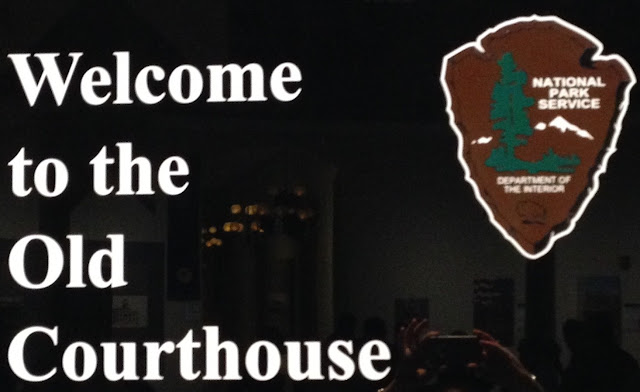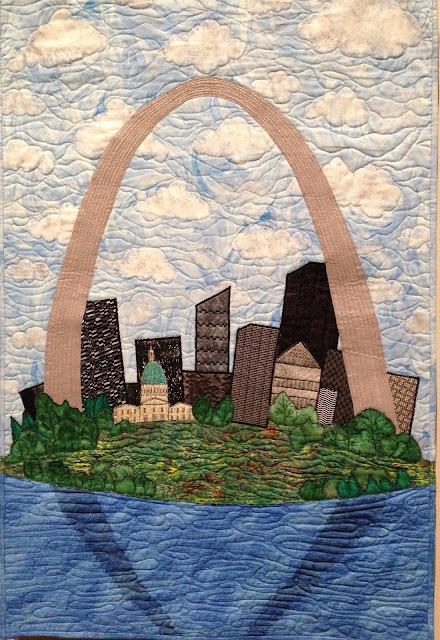St. Louis, MO 63102
Admission: free parking: not free
Ground breaking for the Old Courthouse began in 1839 with the last major change completed in 1864. It was Missouri's largest habitable building from 1864-1894.
The last addition to the courthouse was the dome, begun in 1861 and completed in 1864. Just like the United States Capitol Dome (built also during the Civil War), the dome is modeled after St. Peter's Basilica in Vatican City.
Needless to say under the dome, the interior of the courthouse rotunda is quite impressive and beautiful.
Each of the four lunettes contains a painted mural depicting an event in St. Louis history. The murals were painted right after the 1864 completion of the dome.
The courthouse is particularly known for its most famous case - the 1846 Dred Scott case when the slave sued for his and his wife's freedom. One of the four history galleries at the courthouse is dedicated to slavery and to Dred Scott as shown below in two of the displays. This gallery is a long-time permanent display.
Some of the displays focus specifically on the Scotts and their case.
This display represents life in St. Louis during the year of the trial.
There are a few artifacts. The laundry supplies from the 1800's represent the laundry business that Harriett Scott presumably ran while waiting for the trial to be completed. It was very hard work.
Dred worked at Barnum's hotel where patrons would pay him to carry bags similar to this one on display.
At the end of the exhibit hall, a courtroom is set-up to represent the mid-1800's courtroom.
In the exhibit there is an informative video for viewing.
This wall display represents the struggle for civil rights.
Another somewhat permanent exhibit found in a second gallery is Early St. Louis - the French and the Osage. This life-size house sits in the middle of the gallery. When the St. Louis Arch museum recently closed temporarily, items from that collection were added to this gallery.
This is a model of a typical French house built in St. Louis, noticeably different from a log cabin. Specialized skills needed to build this style house required hiring a carpenter or mason to build it.
Before Europeans came, St. Louis had been the land of the Osage Indians. It was with the Osage tribes that Laclede and other early St. Louis residents traded goods. These artifacts of items traded as well as other artifacts, are on display.
One of the two newer and temporary exhibits in a third gallery centers on Lewis and Clark and Mountain Men. Many of these artifacts and displays came from the Arch museum and will be returned there when it re-opens.
That display shows more artifacts from the days of trading with the Osage Indians.
These are the trappers' tools of the trade.
Trapping beaver was generally done in the fall or spring.
Beaver felt hats, like these on display, were very popular in Europe, and relied on beaver from the American west.
The fourth and final gallery is about Plains Indians and Pioneers.
Like the previous gallery, this one is temporary and was set up when the Arch museum closed for remodeling. Artifacts here are generally on loan from that collection.
This is a life-size covered wagon representing the pioneers.
These are two of the murals representing the pioneers.
In December there is also a temporary display in the rotunda. A group of women from Nebraska quilted 13 quilts representing national parks in honor of the National Park Service Centennial. They are beautiful works of art. I took pictures of three of them. Below is the quilt representing the Jefferson National Expansion Memorial.
This is the Homestead National Monument of America in Beatrice, Nebraska.
This quilt represents Joshua Tree National Park in California.
And of course, no museum is complete without a gift shop. Typical of the national park gift shops, it is quite large.
Comments: Until we visited the courthouse as part of a Christmas tour of three historical city houses, I had no idea that this building held so many displays and exhibits. It is full of the history of the area.
When the Arch museum closed in February 2015, items from the Museum of Westward Expansion were brought to the courthouse which was designated as the Arch administration home until the museum under the Arch reopens. A number of these items were added to three of the galleries. When the new Arch museum reopens, hopefully in 2017, many of these items will return to the Arch museum. As funding becomes available the national parks hope to replace those exhibits with ones that focus on building/architecture/art and the court and different cases.
What this means is that the current displays will not all remain as they are now, but hopefully will be replaced with some just as great and more centered on the courthouse and less on the area of St. Louis.
I am not sure if there are guided tours, but there is a ranger station in the rotunda where one can stop and ask for information.
There is a parking garage nearby.
The National Park Service owns and manages the Old Courthouse.





































No comments:
Post a Comment